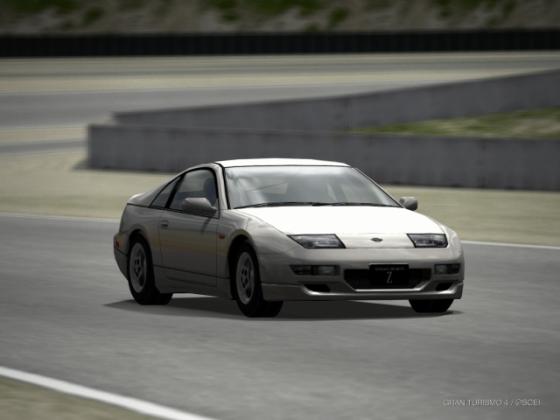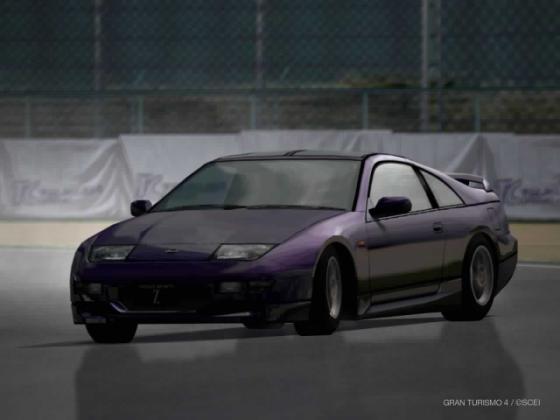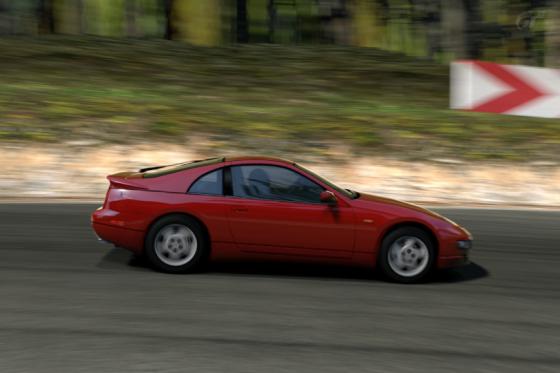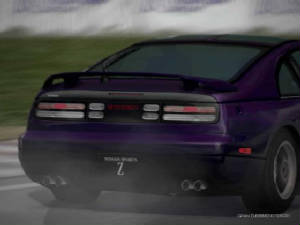|

SPEX
Years Represented: 1989-1999
Class: Sports Car / Grand Tourer
Type: Fastback Coupe
Country: Japan
Host: GT1, GT2, GT3, GT4, & GT5
†Specs below are for a '98 Version R Twin-Turbo from GT2 New Car Lot, as well as the '98 2+2 of GT4
and GT5.
Price: $41,900 (GT2), $21,990 (GT4--used lot), $41,895 (GT5 used
lot)
Construction: unit steel
Length: 177.9" // Width: 70.9" // Height: 49.4"
Wheelbase: 101.2"
Overhang:
6' 5"
Track: 58.9" [F] 60.4" [R]
Ground Clearance: 5.1" (GT2) 4.9" (GT3 & 4)
Weight: 3,483 lbs.
Wgt. Distribution:
54 / 46%
Steering: power-assisted rack & pinion + 4-wheel HICAS
Tires: 225/50ZR-16 [F] 245/45ZR-16 [R]
F. suspension:
multilink, coils, anti-roll bar, angled upr. A-arms, lwr. control arms, shox
R. suspension: multilink, coils, anti-roll
bar, lwr. angled A-arms, shox
Brakes: vented discs + ABS w/vaccuum asst.
Engine: 3.0 litre DOHC V6
Construction: iron block / aluminum
heads
Aspiration: air to air intercooled twin-turbo
Fuel System: ECCS sequential multi-point fuel inj.
Valves per Cyl:
4
Compression Ratio: 8.5:1
Bore x Stroke: 3.43 x 3.27"
GT5 car was not given oil change
or engine rebuild. Doing so would've put it over 286 horsepower, compared to the others this isn't quite fair.
`````````````````````````````GT2`````````````````````````GT4`````````````````GT5```````````
Tested
HP: 276 @ 6,100 rpm 278
@ 6,400 rpm 272 @ 6,200
Tstd Torque: 286
@ 3,600 rpm 288 @ 3,600 rpm 282
@ 3,600
Lbs. per hp: 12.6
12.52 12.80
HP
per Liter: 92
93.9
91.9
Credits per HP: 151.81 79.50
154.02
GT2 Redline: 6,500 // Rev Limit: 8,000
GT4 Idle: 1,000 // Redline: 6,750 // RPM Limit: 7,200 GT5
Idle: 800 // Redline: 6,750 // RPM Limit: 7,250
Layout: Front Engine / Rear Drive
Transmission:
5-speed manual
GT2 version R
0-60 mph: 6.8 seconds 0-100mph:
15.2 seconds
0-150mph: no test
400
M: 15.274 @ 100 mph 1 Kilo: 26.848
@ 132 mph
GT3 '89 2+2 0-60
mph: 6.383 secs
0-100 mph: 15.333 secs
0-150
mph: no test
400
M: 15.155 @ 99 mph 1 Kilo: 26.592 @ 129 mph
0-60 mph: 6.050 secs
0-100 mph: 14.350 secs
0-150 mph: 39.616 secs
400
M: 14.494 @ 100 mph 1 Kilo: 26.039 @ 130 mph
GT5
'98 2+2 0-60 mph: 6.332 secs
0-100 mph: 14.974 secs
0-150 mph: no test
400
M: 14.820 @ 98 mph 1 Kilo: 26.878 @ 129 mph
1
Mile: 46.439 @ 143 mph
Test Track: Not Recorded
100-zero mph: GT2: No test GT3: 3.62
seconds GT4: 3.93 seconds GT5: 5.68 seconds
Top gear
RPM @ 60 mph: 2,400
Top Speed at Redline (GT2 version R Twin-Turbo)
1st: 43 mph (7,500 rpm)
2nd: 73 mph
3rd: 107 mph
4th:
139 mph
5th: 177.27 mph @ 6,800 rpm
Top Speed at Redline (GT4
used '98 2+2)
1st: 40 mph
2nd: 68 mph
3rd: 102 mph
4th: 133 mph
5th: 171.75 mph @ 6,550 rpm (2+2)
````````172.34
mph @ 6,600 rpm (2-seater)
Top Speed at Redline (GT5, used '98 2+2) 1st:
38 mph 2nd: 64 mph 3rd: 98.5 mph 4th: 128.5 mph 5th: 169.4 mph @ 6,750 rpm
(2+2)

-------------------------EXTERIOR---------------------------
Nowadays, the competition between Japanese sports-car manufacturers is either dead or just about
to revive, depending on who you ask. But 10 years ago, several major Japanese car-manufacturers of the '90s firmly had their
feet in the sports-car wars of the times...hottest of all was the war between Toyota's Supra, Mazda's RX-7 and Nissan's
300ZX, with Mitsubishi's 3000GT trailing somewhat.
In the first two games (GT1 & GT2), there are several
versions of 300ZX we can experience from the results of this war. There are four different models (not including used cars),
which most of the world outside the United States calls the Fairlady. You'll notice that in GT1, there are no 300ZXs...in
this game, they're all called "Fairlady ZXs", instead. The reason for this? Way back in 1969 before the original
Z was released, some people associated with the car's debut thought the name "Fairlady" sounded wimpy.
So in America and some other countries, Fairlady was dropped, but in Japan these cars are still called Fairladys.
One
can choose either normally-aspirated or turbocharged versions of the ZX in either GT1 or GT2. Also, there are two subtle
variations of body work: a coupe and the famous T-top, as well as 2-seaters and 2+2s. Whichever car you choose,
be advised that these are some of the heavier sports cars in our games. In GT3, PD scaled
down to just one model (the '89 300ZX Twin Turbo 2+2). And in GT4, we have three models to choose from, all from used
lots, ranging from 1989 to 1998. These include a 2-seater and a couple 2+2s. There are less models in this game since
the 350Z also appears, so PD decided to make room for several 350s, which is fair.
Finally,
GT5 includes a slew of variants. These are all Standards: the '89 300ZX 2-seater, '98 300ZX 2-seater, '98 300ZX
2+2 (the auto I'm mostly focusing on here), and these three are what was to be found on the American market. For
the Japanese there is the '89 Fairlady Z Twin Turbo 2-seater (this car can be had in Premium or Standard trims), the Fairlady
Z Version R Twin Turbo 2+2, and the '98 Fairlady Z Version S Twin Turbo 2-seater.
Some of you may
wonder why I'm choosing to focus on the slightly inferior 2+2 models for this review. It's because only the 2+2 appears in
all Gran Turismo games. So for everything I say about the 2+2, imagine the 2-seater is slightly better, lighter, faster,
etc. Make sense?
Don't know about the rest of the word, but in America the 300ZX and the Corvette are classic "mid-life
crisis" vehicles; cars older men tend to buy when once they've got some money sitting around and want to pretend they're 18
again. Women sometimes buy them too, but typically a mid-life crisis will make them opt for tummy tucks and breast /
butt implants. If they go for a car, it's going to be one for "hairdressers", usually a convertible.
Unlike the Supra and RX-7 (both of which are arguably more race-ready and straddle a fine line
between sports and race car), the Nissan 300ZX is an over-burdened, over-stuffed living room that happens to have
a 3.0 liter V6 engine, and rolls on four wheels! To some, it has a sleek look. But to others, its looks are too bulbous...too
round...not at all like older Z-cars, which it seems Nissan gave more of a sculpted shape. Like the Camaros that appear
in our games, the 300ZX is more aerodynamically sound than older models, but it hasn't got as much personality.
To
any beginners out there: if you don't have finesse with dual-shock controllers or a wheel, the ZX won't be for you. This
is not an automobile for the novice, as the rear-drive Silvia Q's and Sil80 are. If you're new to Gran Turismo 1
or 2 and must drive a 300ZX (because your uncle or your dad drives one), go with a used '95 or '96 car, and don't
get the turbo, yet. The normally-aspirated cars are much easier to handle than the turbocharged machines. Consider yourself
lucky that you've got a choice. For those who are more experienced with sim-driving....read on. (actually, you can keep reading
if you're not that experienced...)
When driven totally stock, the 300ZX handles okay, feels relatively solid, and we
can get some cool low and mid-speed drift & slide maneuvers in ANY GT game with cheaper tires shod. It's also
very possible to find yourself beating all the competition in easier / intermediate races. Now...racing this car on
a more advanced level at a course like Grand Valley or Apricot Hill (both of which include some long, high-speed turns
that aren't banked), is another story. The 300ZX will wallow around like a hippopotamus on steroids once it's got
some speed going!
The difference between a Supra and a 300ZX becomes obvious fast at this level. Although both cars
weigh about the same, give or take 100 pounds, the 300ZX is a tad clumsier..sometimes more than a tad. So the first order
on our checklist is to buy some weight reductions if you're going to take this car to more advanced racing
(which I assume you will be).
The cars in GT3 and GT4 are not immune here. They also feel like over-achievers
at first. Once the 300ZX is doing Amateur Leauge races in GT3, or Professional-level or Special Condition
races in GT4, things start to change. After this, these cars start to feel more and more ponderous.
Again, weight needs to be shaved to solve this.
The 300ZX, unlike its earlier predecessor--the Z car, is heavy because
it's loaded with a bunch of components that have nothing to do with racing. Here we have our heated, fully adjustable
leather seats, automated climate controls, soundproofing material, dual zone airbags, our side-window defoggers, thick-pile
carpeting, interior trim, premium Bose sound system.....you name it, it's an option; and it's all loaded apparently.
Therefore, this is a sporty car... but it's a bit of a luxury car as well. About
384 pounds come off after $32,500 + about $80,000 is spent in GT2 for all weight reductions + racing kit.
The final low can be anywhere from 2,691 pounds for the '95 2-seater to 2,974 pounds
for the '98 Twin Turbo version R. There are so many ZX-cars in GT2, it's dizzying to try and list them all, but you get
the picture. Much more weight can be shed if you're modifying any of the cars found in GT1. The lightest would be the
Fairlady Z Version S 2-seater, which climbs the scale at just 2,112 pounds! Wow.
Compare that to GT4, where the 2-seater still winds up being lightest at 3,350 pounds
to start, but 2,779 with all weight removed. Add about 120 pounds to this and you've got an idea
of what the 2+2 weighs. In GT5, I got my 2+2 all the way down to 2,832.
All these figures are
acceptable for a good number of races in each game, but ultimately the 300ZX isn't guaranteed to make it towards the top depending
which game you've got, strongly due to weight issues. The cars of GT1 and GT2 can win the World Cup if you're skilled,
since any of them can be shod with racing kits and accept titanic power. The FedEx 300ZX-GTS (a prize in GT2) is tops for
those who want to simply find the best ZX.
In GT3 and 4, unfortunately, the 300ZX meets its end eventually. In GT3,
we can't buy any aerodynamics for the 300ZX (or any other car for that matter) which severely hurts once we're working with...let's
say...600 horses. The car in GT4 can be shod with a wing kit, but eventually dies as the game challenges us with its
fastest.
GT5 is the "overachiever" game, in which a car with as much power
as a 300ZX sports won't be useful until later in the game. Well, the Beginner League FR Series can be driven if the car's
power is limited. The Supercar Festival can be tried as well, but anything between these two events will be
destroyed a little too easily.
All ZX models are limited to only seven shades of color, which
includes red, yellow, dark green, and purple on the selectable palette, along with the more professional silver, black,
and white shades. There should be something for everyone, but ultimately some folks might be a little disappointed. But don't
be: the real-life car only came in six or seven colors, too.
ENGINE / DRIVETRAIN------------------------
Once you've
got the money to afford one of these (some are rather expensive...cost varies in the 30 to 40,000 credit range for a newer
car, while a used 300ZX will cost about half this) you'll need to choose which powerplant you would like to have. There are
naturally aspirated and twin-turbo 3.0 liter V6 engines.
A lot of vehicles in the Gran Turismo games don't offer
such variety for the same model, so it's nice to have these options. Most folks will probably go with the twin-turbo,
of course, but any of these should be sufficient to get this car moving. Though the 300ZX accelerates with vigor, it feels
rather sedated from 2nd gear on up. 0 to 60 is achieved in 6.8 seconds with the twin turbo, and 100 mph follows in 15.2. †† See Below. ††
My best results were achieved in the '98
2-seater twin-turbo of GT4, interestingly enough. 0 to 60 in this car ranges anywhere from 5.2 to 5.9 seconds, which is about
what the real-life version is rated at. The 2+2 in this game is about a half-second slower to 60 mph, and generally slower
overall due to extra weight. Oddly, GT4 cars test faster than GT3 cars, which test faster than GT2 cars (see test results
above in the SPEX section). I'm not sure why this is.
Anyways, the famous 300ZX 3-liter has a
wide powerband. Useable torque kicks in nice & early, and during races it's often possible to dig way
down to 3,000 rpms and get moving, although in some games turbo-lag limits this action. The engine is flexible enough, torque
is plentiful, and yet the acceleration in this car doesn't FEEL as exciting as it should--in any car and in any game.
Any
guesses why? Notice the tall gearing. There lies our problem: 3rd peaks just above 100 mph, for instance.
Yes I know the numbers are there, and the engine never sounds as though it's struggling, but it just hasn't
got the right situation to play in. Acceleration runs in a stock 300ZX simply don't burn any extra calories, or
pump extra adrenaline thru my veins. The "too much weight" factor also doesn't help here, although weight doesn't
always initially affect pure acceleration runs the way gearing does.
Close gearing is recommended for all races except
the mega-speed series of GT1. Nissan's factory-set gearing is really tall, especially 4th to 5th; in fact, 5th gear is almost
useless unless one has taken some weight off the body. In GT3 and 4, a stock gearbox is okay for alot of racing once
you've got more power to work with, but many will opt for full-custom gearing anyway.
Using an automatic is really bad for many courses like Route 11, GrindelwŚld or
Autumn Ring, since it constantly causes the engine to rev too low, sometimes far below the proper horsepower
area, so go with a manual gearbox (unless you suck at shifting gears). On courses like the Test Track, Red
Rock Speedway, High Speed Ring, or Midfield, long straights can be fully plundered with stock gearing, since this car
offers us a top speed of 170+ mph totally stock. It also comes standard with a useful 6,500 rpm tachometer in GT1,
GT2, and GT3. In GT4, the redline gets raised slightly to 6,750. Since peak power is located somewhere in the low to mid-6,000s
(stock), we do have some room to work with if we've got a manual transmission, but (again) automatic tranny people will miss
out on those extra revs after redline. This is an engine that can tolerate some redlining.
Depending
which game you've got, the 300ZX can be modded with alot of power, or really a lot of power.
In GT1, naturally-aspirated cars can only make it to 314 hp, hence they're best for novice
drivers, but twin-turbos near 670 with a stage 4 system!
In GT2, power gets upped. Now, Version S natually-aspirated machines can make it to nearly 400 hp,
while the Twin-Turbo socks damn-near 700. If that's not enough for you, the 2+2 in GT3 can be loaded
with up to 4 different turbos and will eventually near 900 horsepower! That's some stoopid power,
there! The kicker is you really can't USE all this power in this game! Unless you're doing a Test Curse run. Without aerodynamic aids, this power is just about useless for racing, especially up against real race cars.
GT4? 300ZXs can be equipped with 5 different turbo systems if you buy parts
from Blitz, HKS or some other Tuner Shop parts plaza. In this game, ultimate power doesn't rate as high as in the 3rd game,
but it's still up there. We have 825 bhp @ 6,400 rpms and 644 foot-pounds
with a stage 4 system (stage 5 is slightly less). This is still plenty...more than I've certainly ever needed! There isn't
much turbo-lag at this level, surprisingly. Also of note is that with this much power, that tall stock transmission no longer
feels so cumbersome...if anything, it starts to feel a bit short!
†† March
13, 2005: I recently took a '95 300ZX 2+2 with normally-aspirated tuning (233 hp) to the test tracks and got to 60 mph
in 6.5 seconds, which is probably due to the fact that I'm a better driver than I was when I originally wrote this
review in June of 2004. By the way, the real-life 300ZX with natural tuning also reliably does 0 to 60 in about 6.5.
GT3
When I
track-tested the car in GT3, I found I could manage a 0 to 60 time of 6.383 seconds (5.866 when dropping the clutch
in 2nd gear at 5,500 rpms) and 0 to 100 of 15.333 (14.83...).
CHASSIS / HANDLING-------------------
I think the main difference between the 300ZX and its hottest competition, the Supra, really starts here. Both cars
have fantastic engines, distinctive looks, but the way each car delivers its message is significantly different.
When stock, the 300ZX has some decent tires on it, as well as above-average spring rates, but these parts are
made for highways with an occasional twisty road thrown in during Sunday drives. It is notable that real-life testers
of the 300ZX never have anything really bad to say about it. But if you're actually gonna RACE the 300ZX, the suspension,
brakes, and sometimes limited-slip needs to be upgraded to handle the weight above, and the mannerisms this car
ultimately starts to display. Notice: lots of dipping....leaning....diving, and squatting. This is not a taut, race-bred
Supra or a nimble RX-7.
As was said before, the multilink suspension and tires should both be beefed up if you're
going to race this car in serious events. In real-life, the 300ZX has 4-wheel steering, simliar to that found in Skylines,
which helps to keep it stable in slower races. In GT4, I think they did manage to model this HICAS steering
system a bit better than in earlier games, because you'll notice that despite the leaning and other negatives this car displays,
it also does manage to get around slower, tighter turns with a lack of understeer that feels downright graceful
at times. But once power is up, the heavy ZX really starts to fishtail and lose traction. So a limited-slip is recommended
here in some games earlier than in others.
Good news is: in GT2 and 3, a totally stock suspension and brakes will
take the Fairlady / 300ZX thru most of the beginner races, and it is possible to win the Clubman and GT2 National A-license
series with these parts, but it is very hard to do so. In GT1, forget it..you'll need to start getting suspension helpings
from NISMO once you're tackling the Clubman. In GT2, Sports tires do well, but quickly lose their effectiveness once
the horsepower gets above 350 or so. In GT3, you'll need racing tires earlier than this.
I've also driven these cars
in GT4, on both N tires and Sports. In this game, the 300ZX drives as in no other previous ones. There is a lack of oversteer, BUT
there's now additional understeer (big surprise). But everything else is generally good. On N2 "comfort" tires and a
stock suspension, the 300ZX is surprisingly fun. The car can lightly or heavily trail-brake into corners (your choice), find
its racing line (as long as you don't over power it), and throttle-oversteers predictably...sometimes ending with a nice semi-drift.
Driving on sports tires erases some of this fun, but provides us with more capabilities for racing. The 300ZX never quite
feels as good as a Supra, though, till you start tuning. Although there is understeer, it thankfully doesn't dominate everything
in this game. At all times, I gotta admit the 300ZX can be compliant and race-worthy, but eventually you gotta start
tuning it heavily, especially as more and more power gets added.
Despite the weight, the 300ZX is a blast to drive
around tracks you know well. It will drift more readily than lighter Nissans, and can be more expressive and exciting to drive
due to the higher level danger in this car. As you raise the power, it goes from being a sporty auto with a large comfort
zone to a dangerously aggressive machine.

---------------------------PROS---------------------
1).
Good power, acceleration, and 170+ mph top speed in an unmodified car. In the real-life versions, speed is
electronically limited, and for good reason, but thankfully we don't have such limits.
2). Several engine options as
well as choices of body style (2 seater or 2+2) in the first 2 games, and in GT4.
3). A challenging car for RWD drifters.
At times the 300 ZX handles like a 4th-gen Mustang, but with taller gears, so keep those revs high.
4). Stock tires
good for unmodified racing in lower levels. Experienced players wont need racing slicks till the engine is stuffed with a
Stage 2 turbo. The car in GT4 displays a wide variety of behaviors on different tires, all of them useful somewhere. Or at
least fun.
5). Low profile body + a stocky girth + all that weight = a highly stable sports coupe.
6). GT1 &
GT2: some ZXs (the '95 Turbo used car and both '98 Twin Turbos) get massive power (650+) when tweaked with all the goods.
And just wait till you raid NISMO's parts department in GT3 & 4! Cars in GT4 can also be equipped with 5 stages of intercooled
turbos, rather than 3 or 4. In any event, each stage of turbo (and sometimes natural power) represents a significant chunk
of new horsepower to play with.
7). Racing kits available for all 300 ZXes from GT1 or GT2.
8). Depending
on the game, some of these cars (used ones, particularly) are priced to move.
---------------------CONS-----------------------
1). Somewhat high price of some versions doesn't guarantee absolute performance. About half the money you spend
on this car is paying for creature comforts you'll never get to enjoy as you armchair-race.
2). Heavy. In some games,
Fairladys REMAIN heavy, too, after weight is lopped off. GT3 & 4 versions are also heavy, but can at least be
box-springed with some phat power.
3). Tall gearing makes for uninspiring acceleration.
4). Suspension, brakes,
tires, and sometimes limited-slip needs to be upgraded before entering intermediate events.
5). As the power
goes up, the Fairlady's trusty lower-speed stability goes down. Fishtailing, spinning rear-wheels, and some understeer gladly
show up to happily greet you like an annoying friend. Not a car for beginners.
6). In the first 2 games, the lesser
300 ZXes can't be tweaked as far as the Twin-Turbos. Pay attention and get the right version early.
7). Since the gearing
is tall, automatic gearboxes aren't very effective in most 300 ZXs, even though the torque band is wide and peak power happens
before the redline.
8). GT4 only: the highly-sought 2-seater in this game is very rare. It can take lots of time
to hunt one down in the late-90s used lot.
9). Some don't like the looks of the 300 ZX generation,
which appears "fattened" and ill-defined when compared to earlier Z cars.
Originally
Published: June 15th, 2004

|

